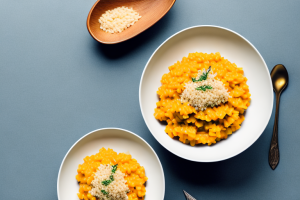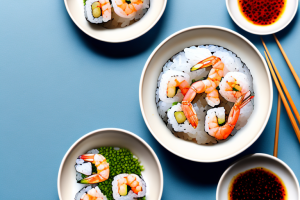How to stir-fry quinoa rice with tofu and broccoli
9 min read
A pan with quinoa rice
Are you tired of cooking the same old boring dish night after night? Why not switch things up and try a delicious and healthy stir-fry? This recipe for stir-fried quinoa rice with tofu and broccoli is easy to make, packed full of flavor, and will leave both your taste buds and your body feeling satisfied. But before we get to the recipe, let’s take a closer look at the health benefits of the ingredients involved.
The health benefits of quinoa rice and tofu
Quinoa rice is a nutritious grain that is high in protein, fiber, and a range of vitamins and minerals. It’s also gluten-free, making it a great option for those with celiac disease or a gluten intolerance. Additionally, quinoa rice is low on the glycemic index, which means it won’t cause a spike in your blood sugar levels.
Tofu is an excellent source of plant-based protein and is low in calories and fat. It’s also rich in calcium, iron, and other minerals that your body needs to function properly. Tofu contains isoflavones, which are compounds that have been shown to have health benefits such as reducing the risk of certain types of cancer and improving heart health.
Another benefit of quinoa rice is that it contains all nine essential amino acids, making it a complete protein source. This is especially important for vegetarians and vegans who may struggle to get enough protein in their diets. Quinoa rice is also versatile and can be used in a variety of dishes, from salads to stir-fries.
When it comes to tofu, it’s important to choose organic, non-GMO options to avoid any potential negative health effects. Additionally, tofu can be prepared in a variety of ways, from grilling to baking, making it a versatile ingredient in many dishes. Incorporating quinoa rice and tofu into your diet can provide numerous health benefits and add variety to your meals.
A beginner’s guide to stir-frying
If you’re new to stir-frying, don’t worry. It’s a simple cooking technique that involves cooking food quickly in an oiled pan over high heat. The key to successful stir-frying is to keep the ingredients moving around the pan, so they cook evenly and don’t stick to the bottom. You’ll also need to have all of your ingredients prepped and ready to go before you start cooking, as stir-frying happens very quickly.
One of the great things about stir-frying is that it’s a versatile cooking method that can be used with a wide variety of ingredients. You can stir-fry vegetables, meats, tofu, and even noodles. This makes it a great option for those who are looking to incorporate more vegetables into their diet, as you can easily add a variety of colorful veggies to your stir-fry.
Another tip for successful stir-frying is to make sure that your pan is hot enough before you start cooking. You want the oil to be shimmering and almost smoking before you add your ingredients. This will help to ensure that your food cooks quickly and evenly, without getting soggy or greasy.
Essential tools and ingredients for stir-frying
The good news is, you don’t need any fancy equipment to stir-fry. All you need is a wok or a large frying pan and a spatula. When it comes to ingredients, you can be as creative as you like. In this recipe, we’ll be using quinoa rice, tofu, and broccoli, but you can use any combination of vegetables and protein that you like.
However, there are a few essential ingredients that are commonly used in stir-fry dishes. These include soy sauce, garlic, ginger, and sesame oil. These ingredients add flavor and depth to your dish, and can be adjusted to your personal taste preferences.
Another important factor to consider when stir-frying is the order in which you add your ingredients. Generally, you want to start with the ingredients that take the longest to cook, such as root vegetables, and gradually add in the quicker-cooking ingredients, such as leafy greens. This ensures that all of your ingredients are cooked evenly and nothing gets overcooked or undercooked.
How to cook perfect quinoa rice for stir-frying
Before we get started with the stir-fry, let’s talk about how to cook perfect quinoa rice. Rinse your quinoa rice under cold water and then add it to a pot with water or vegetable broth. Bring to a boil, reduce the heat, and then cover and let simmer for around 15-20 minutes or until the water is absorbed and the grains are tender.
It’s important to note that the ratio of water to quinoa rice should be 2:1. So, for every cup of quinoa rice, you’ll need two cups of water or vegetable broth. Also, after the rice is cooked, let it sit for a few minutes before fluffing it with a fork. This will help to ensure that the grains are fully cooked and not too sticky. Now that you know how to cook perfect quinoa rice, you’re ready to start stir-frying!
Choosing the right tofu for stir-frying
When it comes to choosing tofu for stir-frying, you’ll want to look for firm or extra-firm tofu. These types of tofu hold their shape well when they’re cooked, which is important when you’re stir-frying. You can find tofu in the refrigerated section of your grocery store.
Another important factor to consider when choosing tofu for stir-frying is the texture. Silken tofu, for example, is too soft and delicate for stir-frying and will break apart easily. On the other hand, super firm tofu can be too tough and chewy. It’s best to stick with firm or extra-firm tofu for stir-frying, as they have the perfect balance of texture and sturdiness.
Preparing broccoli for stir-frying
Broccoli is a great vegetable for stir-frying because it retains its crunch even when it’s cooked. To prepare broccoli for stir-frying, wash it under cold water and then cut it into small florets. You can also cut the stalk into thin slices and include it in the dish.
It’s important to note that when stir-frying broccoli, it’s best to cook it quickly over high heat to maintain its texture and flavor. You can add other vegetables like bell peppers, onions, and carrots to the stir-fry for added color and nutrition. For a protein boost, you can also add tofu, chicken, or shrimp. Serve the stir-fry over rice or noodles for a complete meal.
The best oils to use for stir-frying
When it comes to choosing oils for stir-frying, you’ll want to use oils with a high smoke point, which means they won’t burn at high temperatures. Some good options include peanut oil, sesame oil, and vegetable oil. Avoid using oils with a low smoke point, such as olive oil, as they can burn and produce a bitter taste.
It’s also important to note that different oils can add different flavors to your stir-fry. For example, peanut oil has a nutty flavor that works well with Asian dishes, while sesame oil has a distinct, slightly sweet taste that pairs well with vegetables. Vegetable oil, on the other hand, has a neutral flavor that won’t overpower the other ingredients in your dish. Consider the flavor profile you’re going for when choosing your oil for stir-frying.
How to season your stir-fry for maximum flavor
To add flavor to your stir-fry, you can use a range of different seasonings, such as garlic, ginger, soy sauce, and rice vinegar. Don’t be afraid to experiment with different combinations of flavors to find what works best for you. In this recipe, we’ll be using garlic, ginger, and soy sauce to flavor our stir-fry.
Another great way to add flavor to your stir-fry is by using fresh herbs, such as basil, cilantro, or mint. Simply chop up a handful of your favorite herbs and add them to your stir-fry towards the end of cooking. This will give your dish a burst of fresh, aromatic flavor that will take it to the next level.
Adding other vegetables and protein options to your stir-fry
While quinoa rice, tofu, and broccoli are all great ingredients for a stir-fry, you can also experiment with other vegetables and protein options. Some other great options include bell peppers, mushrooms, carrots, and snap peas. You can also use chicken, beef, or shrimp if you prefer.
Another great vegetable option to add to your stir-fry is bok choy. This leafy green vegetable is packed with nutrients and adds a delicious crunch to your dish. Additionally, if you’re looking for a vegetarian protein option, try adding edamame or chickpeas to your stir-fry. These options are not only high in protein but also add a unique texture to your dish.
Tips for achieving the perfect texture in your stir-fried dish
One of the keys to a great stir-fry is achieving the perfect texture. You’ll want your vegetables to be cooked but still slightly crispy, and your tofu to be slightly browned and crispy on the outside. To achieve this, make sure your wok or pan is heated up before you add your ingredients, and don’t overcrowd the pan. You can also add a bit of cornstarch to your marinade to help thicken up the sauce.
Another tip for achieving the perfect texture in your stir-fry is to cut your ingredients into uniform sizes. This will ensure that they cook evenly and at the same rate. Additionally, try to use fresh ingredients as much as possible, as they will have a better texture than frozen or canned options. Finally, don’t be afraid to experiment with different cooking techniques, such as blanching or parboiling, to achieve the desired texture in your ingredients before adding them to the stir-fry.
How to plate your stir-fry like a pro
Once your stir-fry is cooked, it’s time to plate it up. To make your dish look more visually appealing, try arranging the ingredients in a circular pattern on a large plate. You can also sprinkle some sesame seeds on top for added crunch and flavor.
Another way to elevate the presentation of your stir-fry is to use a variety of colors and textures. Consider adding some sliced bell peppers or carrots for a pop of color, or some chopped peanuts or cashews for a contrasting texture. Don’t be afraid to get creative with your plating and experiment with different arrangements until you find one that looks as good as it tastes.
Creative ways to repurpose leftover stir-fry
If you have leftovers, don’t let them go to waste. You can use the stir-fry as a filling for wraps or sandwiches, or you can add it to a bowl of rice or noodles for an easy and filling lunch the next day. You can also freeze leftover stir-fry for up to three months.
Another great way to repurpose leftover stir-fry is to use it as a topping for a baked potato. Simply heat up the stir-fry and spoon it over a baked potato for a quick and easy meal. You can also add some shredded cheese or sour cream for extra flavor.
If you’re feeling adventurous, you can even use leftover stir-fry as a pizza topping. Spread some tomato sauce on a pizza crust, add the stir-fry, and top with cheese before baking in the oven. This is a fun and unique way to enjoy your leftovers.
Frequently asked questions about cooking with quinoa rice, tofu, and broccoli
Q: Can I use pre-cooked quinoa rice for this recipe?
A: Yes, you can use pre-cooked quinoa rice if you want to save time.
Q: Can I use frozen broccoli in this recipe?
A: Yes, you can use frozen broccoli, but it may be slightly softer than fresh broccoli.
Q: Can I cook the tofu and broccoli together?
A: It’s better to cook them separately to ensure that they both cook evenly.
With these tips and tricks, you’ll be able to whip up a delicious stir-fry in no time. So what are you waiting for? Grab your ingredients and get cooking!


